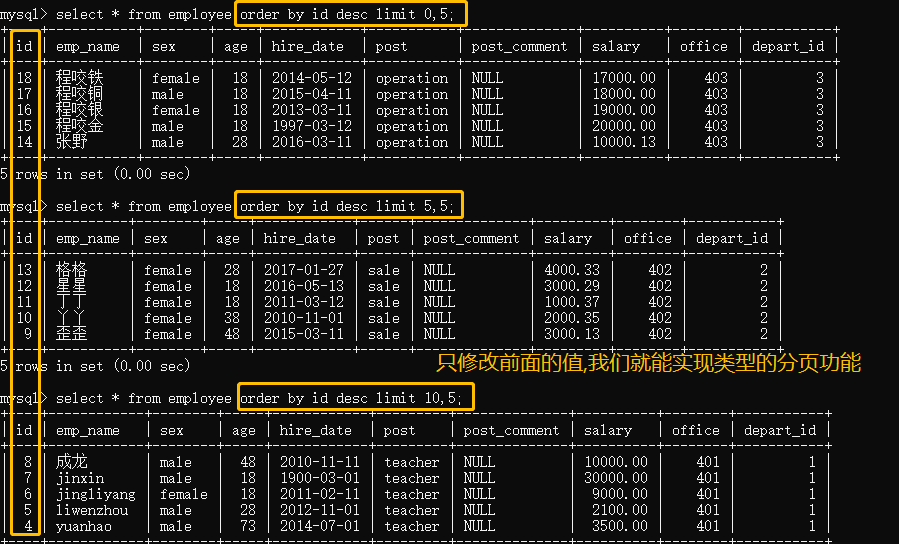mysql 单表查询
单表查询
- 单表查询
- 准备数据
- 简单查询
- 比较运算符
- 范围筛选 between
- 多选 in
- 模糊查询 like
- 逻辑运算符:在多个条件直接可以使用逻辑运算符 and or not
- 身份运算 - 关于null is null /is not null
- 正则匹配 regexp
- 分组 group by
- 聚合 (把很多行的同一个字段进行一些统计,最终的到一个结果)
- 分组+聚合
- HAVING过滤
- having 条件 # 过滤 组
- ORDER BY 查询排序
- order by 某一个字段 asc; 默认是升序asc(Ascending升序) 从小到大
- select emp_name,age from employee order by age; 年龄按照从小到大排序
- order by 某一个字段 desc; 指定降序排列desc(Descending)从大到小
- select emp_name,age from employee order by age desc; 年龄按照从大到小排序
- select emp_name,hire_date from employee order by hire_date desc; 入职日期从早到晚排序
- order by 第一个字段 asc,第二个字段 desc;指定先根据第一个字段升序排列,在第一个字段相同的情况下,再根据第二个字段排列
- select emp_name,age,salary from employee order by age,salary desc;
- LIMIT 限制查询的记录数
准备数据
-
只是把查询结果按照自己想要的方式返回,不对数据做修改
#准备表和记录
company.employee #设计表结构
员工id id int
姓名 emp_name varchar
性别 sex enum
年龄 age int
入职日期 hire_date date
岗位 post varchar
职位描述 post_comment varchar
薪水 salary double
办公室 office int
部门编号 depart_id int
#建表和数据准备
create table employee(
id int not null unique auto_increment,
emp_name varchar(20) not null,
sex enum('male','female') not null default 'male', #大部分是男的
age int(3) unsigned not null default 28,
hire_date date not null,
post varchar(50),
post_comment varchar(100),
salary double(15,2),
office int, #一个部门一个屋子
depart_id int
);
#查看表结构
mysql> desc employee;
+--------------+-----------------------+------+-----+---------+----------------+
| Field | Type | Null | Key | Default | Extra |
+--------------+-----------------------+------+-----+---------+----------------+
| id | int(11) | NO | PRI | NULL | auto_increment |
| emp_name | varchar(20) | NO | | NULL | |
| sex | enum('male','female') | NO | | male | |
| age | int(3) unsigned | NO | | 28 | |
| hire_date | date | NO | | NULL | |
| post | varchar(50) | YES | | NULL | |
| post_comment | varchar(100) | YES | | NULL | |
| salary | double(15,2) | YES | | NULL | |
| office | int(11) | YES | | NULL | |
| depart_id | int(11) | YES | | NULL | |
+--------------+-----------------------+------+-----+---------+----------------+
#插入数据
#三个部门:教学,销售,运营
insert into employee(emp_name,sex,age,hire_date,post,salary,office,depart_id) values
('egon','male',18,'20170301','鸡汤导师',7300.33,401,1), #以下是教学部
('alex','male',78,'20150302','teacher',1000000.31,401,1),
('wupeiqi','male',81,'20130305','teacher',8300,401,1),
('yuanhao','male',73,'20140701','teacher',3500,401,1),
('liwenzhou','male',28,'20121101','teacher',2100,401,1),
('jingliyang','female',18,'20110211','teacher',9000,401,1),
('jinxin','male',18,'19000301','teacher',30000,401,1),
('成龙','male',48,'20101111','teacher',10000,401,1),
('歪歪','female',48,'20150311','sale',3000.13,402,2),#以下是销售部门
('丫丫','female',38,'20101101','sale',2000.35,402,2),
('丁丁','female',18,'20110312','sale',1000.37,402,2),
('星星','female',18,'20160513','sale',3000.29,402,2),
('格格','female',28,'20170127','sale',4000.33,402,2),
('张野','male',28,'20160311','operation',10000.13,403,3), #以下是运营部门
('程咬金','male',18,'19970312','operation',20000,403,3),
('程咬银','female',18,'20130311','operation',19000,403,3),
('程咬铜','male',18,'20150411','operation',18000,403,3),
('程咬铁','female',18,'20140512','operation',17000,403,3)
;
#ps:如果在windows系统中,插入中文字符,select的结果为空白,可以将所有字符编码统一设置成gbk
简单查询
-
指定字段查询
-
select id ,emp_name,sex,age,hire_date,post,post_comment,salary,office,depart_id from employee;
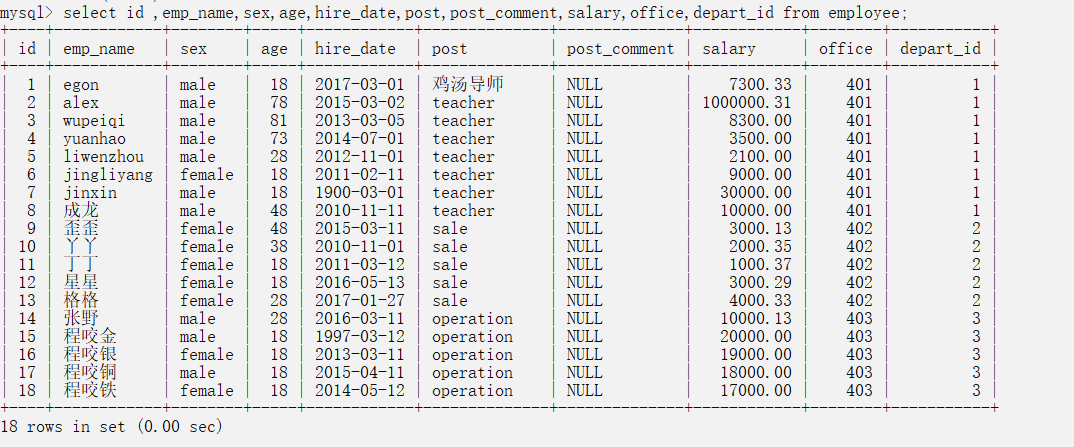
- select emp_name,salary from employee;

-
查看所有字段
-
select * from employee;
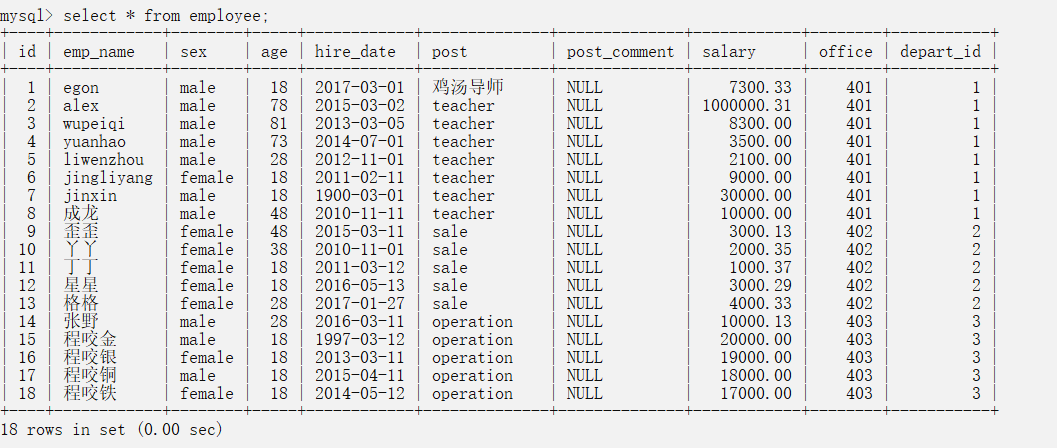
-
避免重复distinct
-
select distinct post from employee;

-
通过四则运算查询
-
select emp_name,salary*12 from employee;
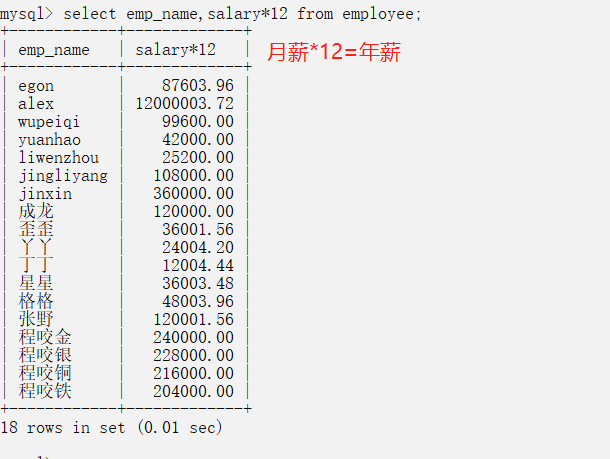
- select emp_name,salary*12 as Annual_salary from employee;

- select emp_name,salary*12 Annual_salary from employee;
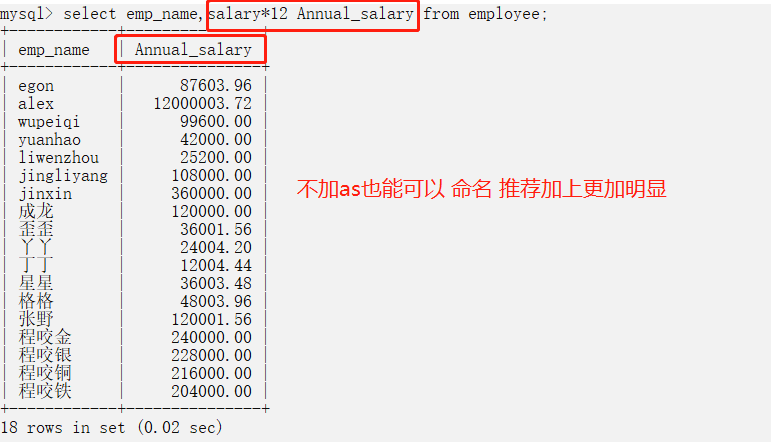
-
定义显示格式 concat() 函数用于连接字符串
-
select concat('姓名:',emp_name,'年薪:',salary*12) as Annual_salary from employee;
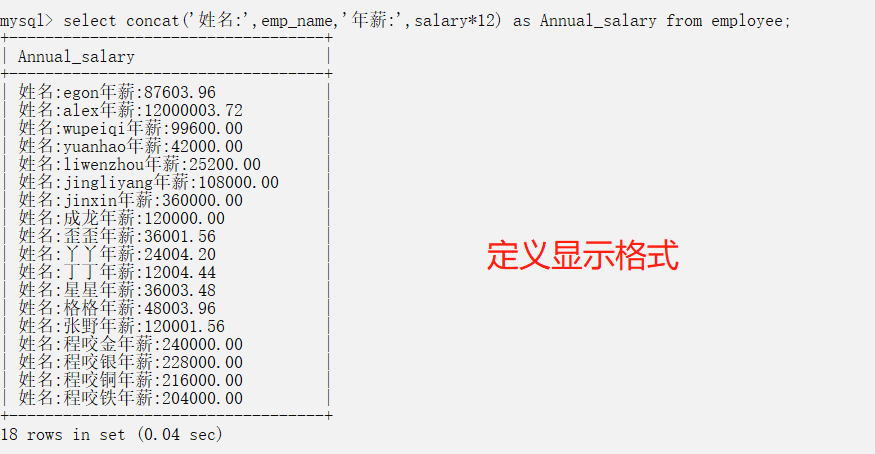
-
concat_ws() 第一个参数为分隔符
-
select concat_ws(':',emp_name,salary*12) as Annual_salary from employee;

- 结合CASE语句
- select( case when emp_name = 'jingliyang' then emp_name when emp_name = 'alex' then concat(emp_name,'_bigsb') else concat(emp_name, '棒棒哒') end ) as new_name from employee;
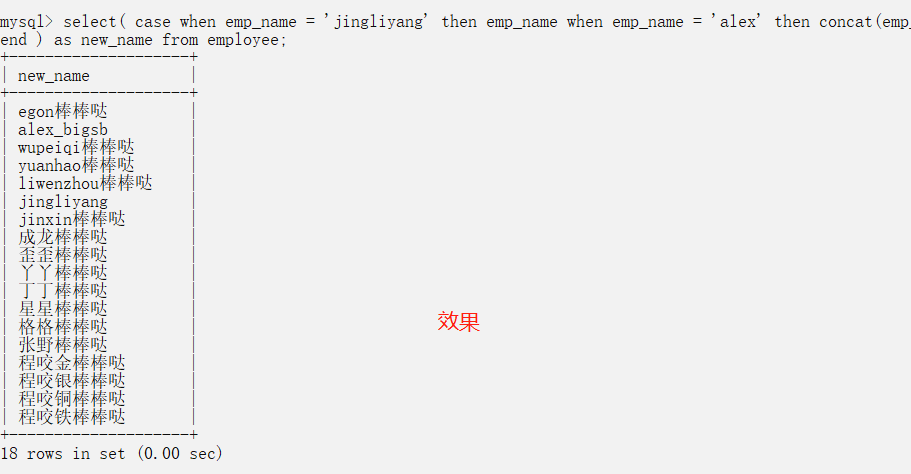
比较运算符
-
大于 > 小于< 等于= 大于等于 >= 小于等于<= 不等于 != 不等于<>

范围筛选 between
-
between 80 and 100 值在80到100之间
-
在一个模糊的范围里 between 10000 and 20000 salary 是1w-2w之间的所有人的名字
-
select emp_name from employee where salary between 10000 and 20000;

多选 in
- 字段名 in (值1,值2,值3)
- select * from employee where salary in (20000,30000,3000,19000,18000,17000);

模糊查询 like
-
通配符可以是%或_ %表示任意多字符 _表示一个字符
-
select * from employee where emp_name like '程%';

逻辑运算符:在多个条件直接可以使用逻辑运算符 and or not
-
逻辑运算 - 条件的拼 (与 and) (或 or) (非 not)
-
select * from employee where emp_name not in ('程咬金','程咬银','程咬铜');
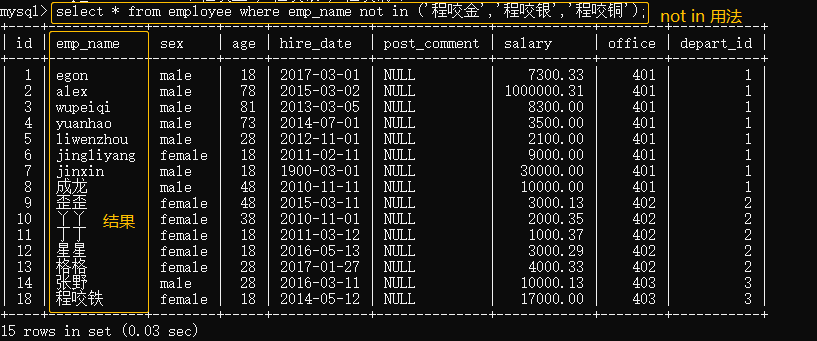
- select * from employee where emp_name not like ('程%');

-
select emp_name,salary*12 from employee where post='operation' and emp_name like '程%';- 查看岗位是operation且名字是程开头的员工姓名、年薪

- 查看岗位是operation且名字是程开头的员工姓名、年薪
-
select * from employee where salary = 20000 or salary = 30000;

-
select * from employee where emp_name = '丫丫' or emp_name = '丁丁' or emp_name = '星星' or emp_name = '格格'or salary = 20000;

身份运算 - 关于null is null /is not null
-
查看岗位描述为NULL的员工信息
-
select * from employee where post_comment is not null;
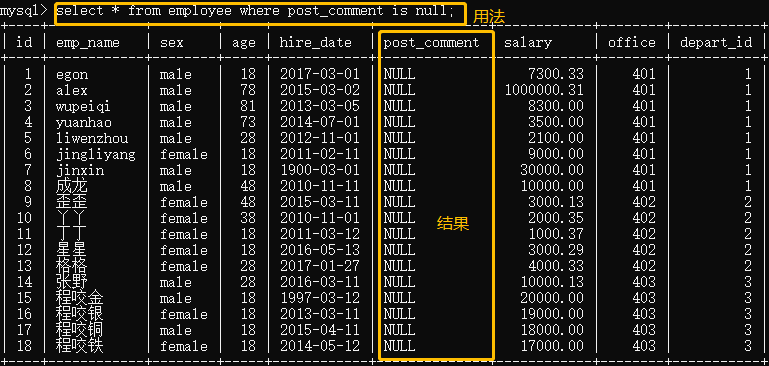
正则匹配 regexp
-
更加细致的匹配的时候使用 select * from 表 where 字段 regexp 正则表达式
-
select emp_name,salary*12 from employee where post='teacher' and emp_name regexp '^jin.*'

select * from employee where emp_name regexp '^j[a-z]{5}'

分组 group by
#单独使用GROUP BY关键字分组
mysql> select post from employee group by post;
+--------------+
| post |
+--------------+
| operation |
| sale |
| teacher |
| 鸡汤导师 |
+--------------+
4 rows in set (0.02 sec)
注意:我们按照post字段分组,那么select查询的字段只能是post,想要获取组内的其他相关信息,需要借助函数
#GROUP BY关键字和GROUP_CONCAT()函数一起使用
mysql> select post,group_concat(emp_name) from employee group by post;#按照岗位分组,并查看组内成员名
+--------------+---------------------------------------------------------+
| post | group_concat(emp_name) |
+--------------+---------------------------------------------------------+
| operation | 程咬铁,程咬铜,程咬银,程咬金,张野 |
| sale | 格格,星星,丁丁,丫丫,歪歪 |
| teacher | 成龙,jinxin,jingliyang,liwenzhou,yuanhao,wupeiqi,alex |
| 鸡汤导师 | egon |
+--------------+---------------------------------------------------------+
4 rows in set (0.04 sec)
mysql> select post,group_concat(emp_name) as emp_members from employee group by post;
+--------------+---------------------------------------------------------+
| post | emp_members |
+--------------+---------------------------------------------------------+
| operation | 程咬铁,程咬铜,程咬银,程咬金,张野 |
| sale | 格格,星星,丁丁,丫丫,歪歪 |
| teacher | 成龙,jinxin,jingliyang,liwenzhou,yuanhao,wupeiqi,alex |
| 鸡汤导师 | egon |
+--------------+---------------------------------------------------------+
4 rows in set (0.00 sec)
#GROUP BY与聚合函数一起使用
select post,count(id) as count from employee group by post;#按照岗位分组,并查看每个组有多少人
+--------------+-------+
| post | count |
+--------------+-------+
| operation | 5 |
| sale | 5 |
| teacher | 7 |
| 鸡汤导师 | 1 |
+--------------+-------+
4 rows in set (0.02 sec)
-
select * from employee group by post;

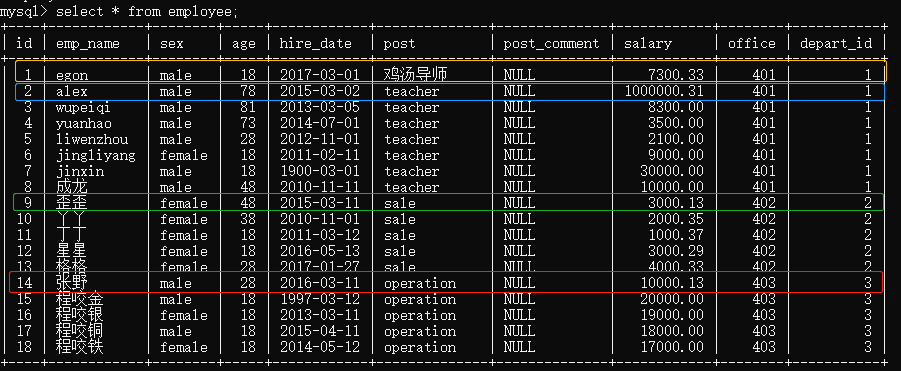
-
分组会把在group by后面的这个字段,也就是post字段中的每一个不同的项都保留下来
-
并且把值是这一项的的所有,行归为一组,但是只显示第一个分组匹配上值的所有数据,且一般默认倒序显示,数值的默认从小到大排序.
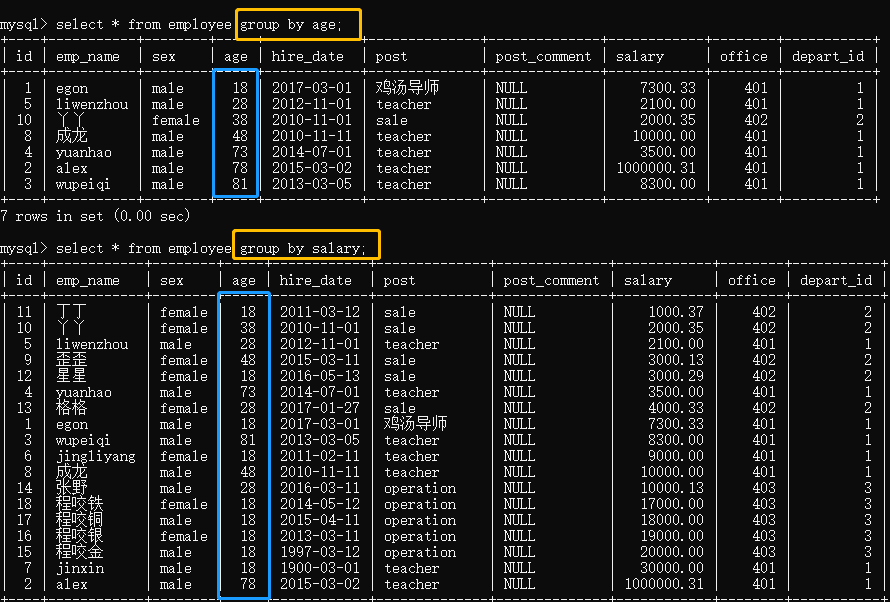
聚合 (把很多行的同一个字段进行一些统计,最终的到一个结果)
#强调:聚合函数聚合的是组的内容,若是没有分组,则默认一组
示例:
# count(字段/*) 统计这个字段有多少项
select count(id) from employee;
+-----------+
| count(id) |
+-----------+
| 18 |#结果
+-----------+
1 row in set (0.00 sec)
select count(*) from employee where depart_id=1;
+----------+
| count(*) |
+----------+
| 8 |#结果
+----------+
1 row in set (0.00 sec)
# max(字段) 统计这个字段对应的数值的最大值(薪资)
select max(salary) from employee;
+-------------+
| max(salary) |
+-------------+
| 1000000.31 |#结果
+-------------+
1 row in set (0.03 sec)
# min(字段) 统计这个字段对应的数值的最小值(薪资)
select min(salary) from employee;
+-------------+
| min(salary) |
+-------------+
| 1000.37 |#结果
+-------------+
1 row in set (0.00 sec)
# avg(字段) 统计这个字段对应的数值的平均值(薪资)
select avg(salary) from employee;
+--------------+
| avg(salary) |
+--------------+
| 64844.568889 |#结果
+--------------+
1 row in set (0.00 sec)
# sum(字段) 统计这个字段对应的数值的和
mysql> select sum(salary) from employee;
+-------------+
| sum(salary) |
+-------------+
| 1167202.24 |#结果
+-------------+
1 row in set (0.00 sec)
select sum(salary) from employee where depart_id=3;
+-------------+
| sum(salary) |
+-------------+
| 84000.13 |#结果
+-------------+
1 row in set (0.00 sec)
分组+聚合
一 concat()函数
1、功能:将多个字符串连接成一个字符串。
2、语法:concat(str1, str2,...)
返回结果为连接参数产生的字符串,如果有任何一个参数为null,则返回值为null。
3、语法:concat(str1, seperator,str2,seperator,...)
返回结果为连接参数产生的字符串并且有分隔符,如果有任何一个参数为null,则返回值为null。
二 concat_ws()函数
1、功能:和concat()一样,将多个字符串连接成一个字符串,但是可以一次性指定分隔符(concat_ws就是concat with separator)
2、语法:concat_ws(separator, str1, str2, ...)
说明:第一个参数指定分隔符。需要注意的是分隔符不能为null,如果为null,则返回结果为null。
三 group_concat()函数
1、功能:将group by产生的同一个分组中的值连接起来,返回一个字符串结果。
2、语法:group_concat( [distinct] 要连接的字段 [order by 排序字段 asc/desc ] [separator '分隔符'] )
说明:通过使用distinct可以排除重复值;如果希望对结果中的值进行排序,可以使用order by子句;separator是一个字符串值,缺省为一个逗号。
1. 查询岗位名以及岗位包含的所有员工名字
mysql> select post,group_concat(emp_name) from employee group by post;
+--------------+---------------------------------------------------------+
| post | group_concat(emp_name) |
+--------------+---------------------------------------------------------+
| operation | 程咬铁,程咬铜,程咬银,程咬金,张野 |
| sale | 格格,星星,丁丁,丫丫,歪歪 |
| teacher | 成龙,jinxin,jingliyang,liwenzhou,yuanhao,wupeiqi,alex |
| 鸡汤导师 | egon |
+--------------+---------------------------------------------------------+
2. 查询岗位名以及各岗位内包含的员工个数
mysql> select post,count(emp_name) from employee group by post ;
+--------------+-----------------+
| post | count(emp_name) |
+--------------+-----------------+
| operation | 5 |
| sale | 5 |
| teacher | 7 |
| 鸡汤导师 | 1 |
+--------------+-----------------+
3. 查询公司内男员工和女员工的个数
select sex, count(id) from employee group by sex;
+--------+-----------+
| sex | count(id) |
+--------+-----------+
| male | 10 |
| female | 8 |
+--------+-----------+
4. 查询岗位名以及各岗位的平均薪资
select post,avg(salary) from employee group by post;
+--------------+---------------+
| post | avg(salary) |
+--------------+---------------+
| operation | 16800.026000 |
| sale | 2600.294000 |
| teacher | 151842.901429 |
| 鸡汤导师 | 7300.330000 |
+--------------+---------------+
5. 查询岗位名以及各岗位的最高薪资
select post,max(salary) from employee group by post;
+--------------+-------------+
| post | max(salary) |
+--------------+-------------+
| operation | 20000.00 |
| sale | 4000.33 |
| teacher | 1000000.31 |
| 鸡汤导师 | 7300.33 |
+--------------+-------------+
6. 查询岗位名以及各岗位的最低薪资
select post,min(salary) from employee group by post;
+--------------+-------------+
| post | min(salary) |
+--------------+-------------+
| operation | 10000.13 |
| sale | 1000.37 |
| teacher | 2100.00 |
| 鸡汤导师 | 7300.33 |
+--------------+-------------+
7. 查询男员工与男员工的平均薪资,女员工与女员工的平均薪资
select sex,avg(salary) from employee group by sex;
+--------+---------------+
| sex | avg(salary) |
+--------+---------------+
| male | 110920.077000 |
| female | 7250.183750 |
+--------+---------------+
HAVING过滤
#HAVING与WHERE不一样的地方在于!!!!!!
1. 执行优先级从高到低:where > group by > having
2. Where 发生在分组group by之前,因而Where中可以有任意字段,但是绝对不能使用聚合函数。
3. Having发生在分组group by之后,因而Having中可以使用分组的字段,无法直接取到其他字段,可以使用聚合函数
-
having 条件 # 过滤 组
-
select count(id) as '人数',post from employee group by post having count(*) > 3; 找出部门人数大于3的部门

-
select post '均薪资>10000部门' from employee group by post having avg(salay)>10000; 平均薪资大于10000的部门

-
select * from employee having age>18 年龄大于18岁的

-
ORDER BY 查询排序
-
order by 某一个字段 asc; 默认是升序asc(Ascending升序) 从小到大
-
select emp_name,age from employee order by age; 年龄按照从小到大排序
-
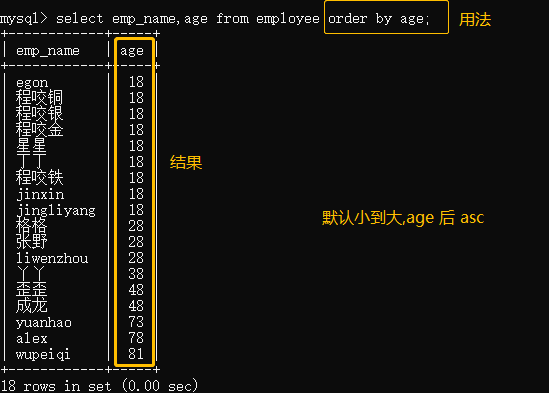
-
order by 某一个字段 desc; 指定降序排列desc(Descending)从大到小
-
select emp_name,age from employee order by age desc; 年龄按照从大到小排序
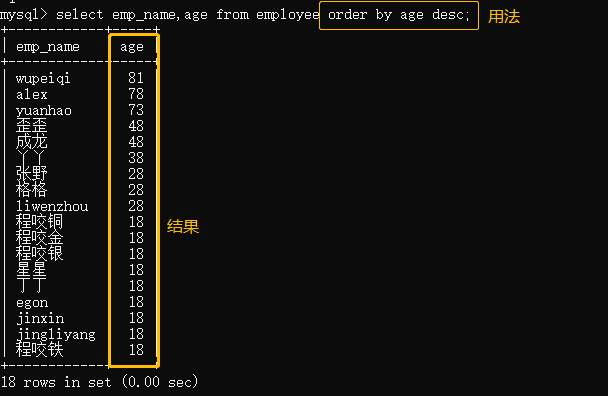
-
select emp_name,hire_date from employee order by hire_date desc; 入职日期从早到晚排序

-
order by 第一个字段 asc,第二个字段 desc;指定先根据第一个字段升序排列,在第一个字段相同的情况下,再根据第二个字段排列
-
select emp_name,age,salary from employee order by age,salary desc;
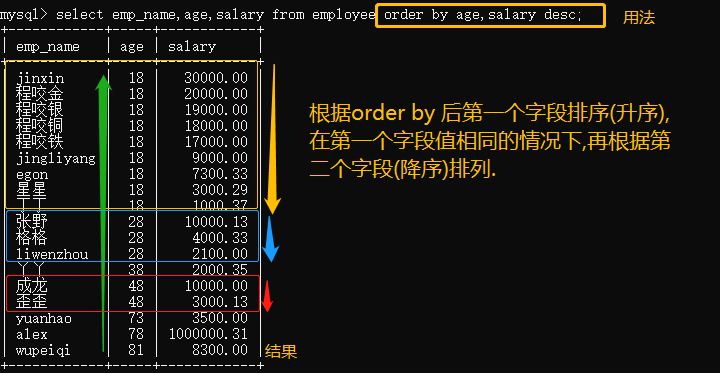
-
LIMIT 限制查询的记录数
-
取前n个 limit n == limit 0,n
-
select emp_name,salary from employee order by salary desc limit 3; 找出薪资最高的三个人,从多到少排序
-

-
分页 limit m,n 从m+1开始取n个
-
员工展示的网页,18个员工,每一页展示5个员工
-
limit n offset m == limit m,n 从m+1开始取n个
- select * from employee order by id desc limit 0,5;
- select * from employee order by id desc limit 5,5;
- select * from employee order by id desc limit 10,5;
- select * from employee order by id desc limit 15,5;
